Ironing Board Sam plays on at the National Museum of African American Music in Nashville
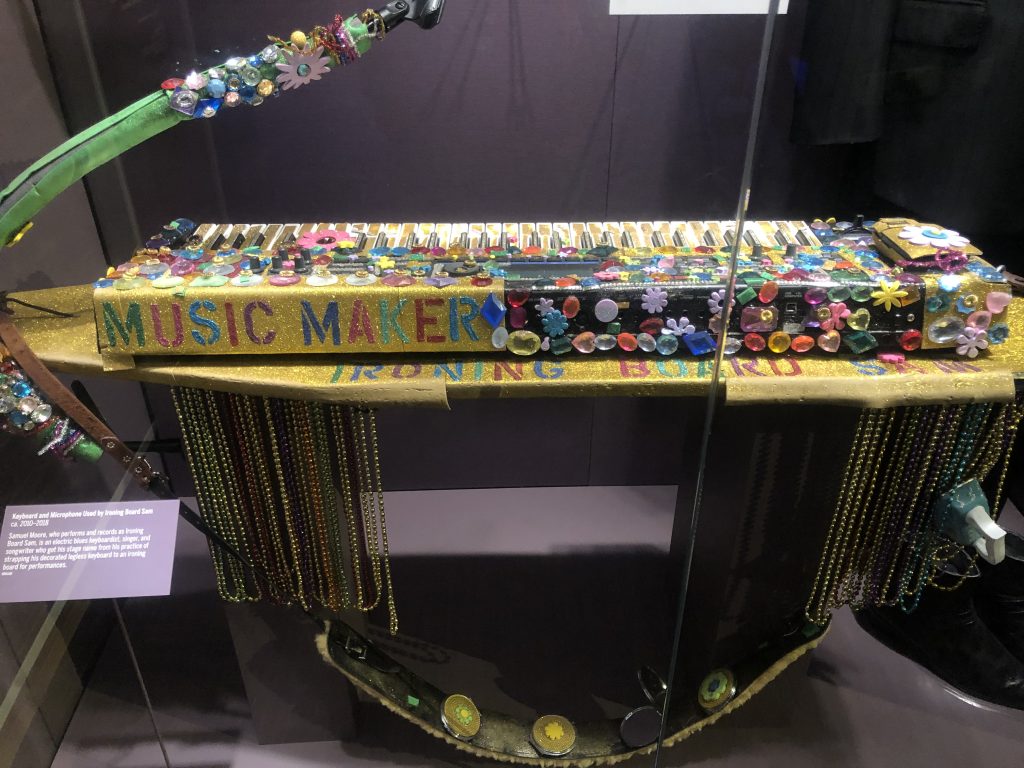
Ironing Sam’s keyboard at NMAAM. I was so happy to see this.
NASHVILLE, TN.–For an edifice fixed in time, a museum can move in many ways. There are moments of discovery and minutes of connection. A museum can be a unifier.
Over Christmas, my brother and I visited the two-year-old National Museum of African American Music (NMAAM) in downtown Nashville. The magnificent 56,000-square-foot museum is a block away from the historic Ryman Auditorium. There are more than 1,500 artifacts, objects, and photos and many of them have Chicago connections: Chess Records, Mahalia Jackson, Sam Cooke, The Staple Singers, Oscar Brown, Jr., and more.
But I bonded with a distant friend.
I smiled when I saw the festive keyboard that belonged to blues singer Ironing Board Sam (Sam Moore) I met Moore in January 1986 in New Orleans. I was on assignment to find wacky Super Bowl feature stories for the Chicago Sun-Times and Ironing Board Sam was performing at the tiny Bourbon Street After Hours club on Bourbon Street. I watched his show one night and returned for an interview the next night.
Moore was born on July 17, 1939, in Rock Hill, S.C. and some of his formative music years were in Chicago. He played Pepper’s Lounge, 43rd Street and Vincennes Avenue, and Club De Lisa, just south of Pepper’s. In the early 1960s, Moore (not the Sam Moore of Sam & Dave) migrated to Memphis where he performed on Beale Street. “The Ironing Board name kicked in when I played Memphis,” he told me in 1986. “I had the ironing board done in red velvet and if the music is right, the people in Memphis feel they know you. So they started calling me Ironing Board Sam.”
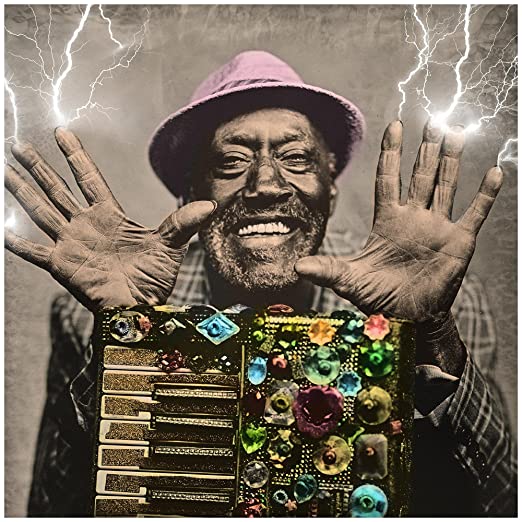
The joy of Ironing Board Sam Moore (Photo by Tim Duffy.)
Moore hatched the steam-pressed idea when he was building his first DIY keyboard. A kitchen table was the only place he could work on his keyboard. “My dad kept telling me to get it off the table so one day I was passing a hardware store and saw an ironing board,” he said. “I thought that would be the best thing for my keyboard.” Moore created his first “button board” keyboard in the 1960s from upholstery tacks wired to 64 radio tubes. It was mounted on a 2 x 4 that sat on the ironing board.
The Ironing Sam keyboard in the NMAAM museum was donated by the Music Maker Foundation, a nonprofit organization that assists elder Southern roots musicians. Founded in 1994, Music Maker helped launch the careers of the Carolina Chocolate Drops and they’re an advocate for the fine Chicago blues singer Mary Lane. The foundation gifted the beautiful keyboard to Moore in 2014. The newer boutique Roland DS61 is heavily decorated with Mardi Gras beads and ornaments. It makes everyone smile. The keyboard was deemed the favorite museum item from the Savannah Morning News.
Music Maker president and co-founder Tim Duffy garnished the keyboard and gave it to Moore as a surprise. “There’s a lot of money on that board,” Duffy said with a chuckle in a phone conversation earlier this week from his home in Hillsborough, N.C. “We saw pictures of him where he had an ironing board with straps so we also built that. Sam said he was going back to (New Orleans) jazz fest and he needed to make a splash. He wanted to dress up like an astronaut. We looked everywhere but we couldn’t find a space suit. So we made him a gold lame’ suit.”
Moore was over the moon about the suit and wondered if his keyboard could match the suit. One day he left his keyboard in the studio and that’s when Moore and his staff ordered the Mardi Gras beads and decorated it. “We are proud to be a little piece of the Sam cult,” Duffy said. “One time he had a wind-up monkey that played on top of his keyboards. Sam was all about the show.
“People love Sam because he’s a dreamer.”
Duffy also saw Ironing Board Sam perform frequently on Bourbon Street during the 1980s. “A little before (Hurricane) Katrina and after Katrina I didn’t see him anymore,” he said. “There was a period of seven, eight years that no one heard from him. A friend of mine was driving back from somewhere and stopped in Rock Hill. He was playing this dinky sports bar steakhouse. He was broke and getting evicted. We drove back the next day with my van and asked if he wanted to live by Music Maker in Hillsborough. He moved up the next day. We rented him an apartment. We got his career back together.”
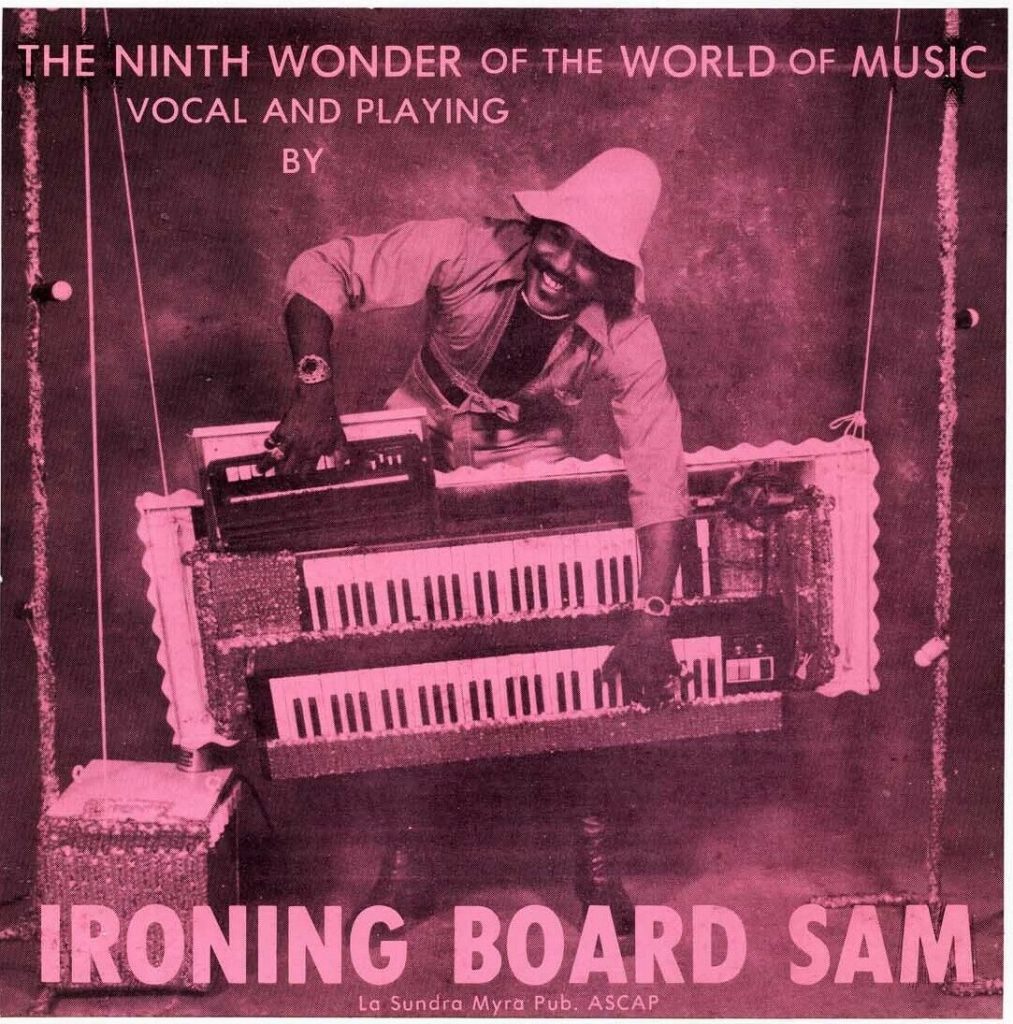
Music Maker helped Moore release his 2015 “Super Spirit” (Big Legal Mess), a deep blues-gospel album empathetically co-produced by Jimbo Mathus (Jim Dickinson, Eric Ambel) and Bruce Watson (R.L. Burnside, T-Model Ford).
The project was recorded at Watson’s studio in Water Valley, Ms. In the swampy spoken word title track Moore declares, “True love means no harm…all human beings are related.” Moore, 84, suffered a stroke in 2020 and is now living with family in Montgomery, Al.
Of course, over the years the colorful Moore caught the eyes of many musical passers-by with his ironing board keyboard. One Memphis audience member owned the Club Del Morocco on Jefferson Street in downtown Nashville. He brought Moore to his club, which at the time also included up-and-comers Jimi Hendrix and Billy Cox. In 1965 Ironing Board Sam appeared on the popular “Night Train” rhythm and blues television show in Nashville.
In New Orleans Moore became best known for driving a Cadillac fitted with chandeliers and performing while submerged in a 1,500-gallon aquarium at the 1977 New Orleans Jazz & Heritage Festival fairgrounds. “I had planned to rent me a helicopter and swing around the fairgrounds playing upside down,” Moore told me. “I found out I couldn’t do that. But I did find a hot-air balloon and tried to play above Jackson Square that summer. But we couldn’t get the balloon off the ground and I was disappointed because I had all the media there and everything.
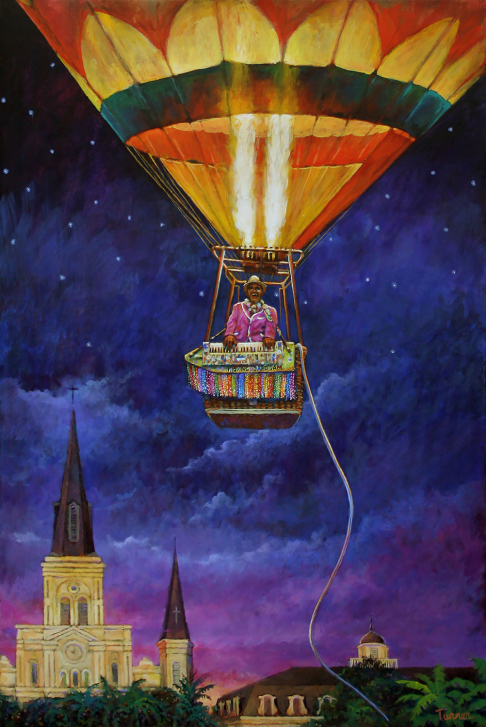
New Orleans artist John Turner celebrates Sam’s aborted dream.
“So I decided to concentrate on things on the ground. Someone heard about all my problems and they said, ‘Why don’t you play underwater?’” Moore began constructing a Plexiglass pool, but during construction, the first tank broke because it wasn’t strong enough to hold water. Moore recruited a welder who steel-framed the tank.
Moore refused to perform with an oxygen tank underwater. “I didn’t want to cheat,” he said. “I made a helmet out of Plexiglass and I breathed the air that was captured when I went under the water. I was able to sing two songs. I did the Jimmy Reed song,” and he started singing “You got me runnin’, I’m goin’ up, I’m goin’ down, up down, up down…” He then added, “You know, I used to practice underwater in my backyard. I began to enjoy it because very seldom you can get total quietness on earth.”
And this was years before social media.
Ironing Board Sam’s Chicago Bears/Super Bowl week sets included covers of “Everyday I Have the Blues” and “Roll Over Beethoven” as well as originals such as “Boogie Ironing Board” and “Ironin’-Em.” He admitted, “I’ll often go into a song and I won’t finish it because sometimes on Bourbon Street you have to catch the crowd’s attention. If they don’t get the exciting part, they’ll drift away. Every song has to have an exciting part.”
Besides launching Music Maker, Duffy is also an acclaimed photographer. In 2019 his exhibition “Blue Muse” was presented at the New Orleans Museum of Art (NOMA.) The show featured tintypes of roots musicians such as Robert Finley, Alabama Slim, and of course Ironing Board Sam. Duffy made the portraits between 2013 and 2016. “It was a big deal,” Duffy said. “Sam was able to come and perform. That meant a lot to him. As part of the public art around town, there’s a huge picture of him in front of the visitor’s center. Four years later it is still up.”
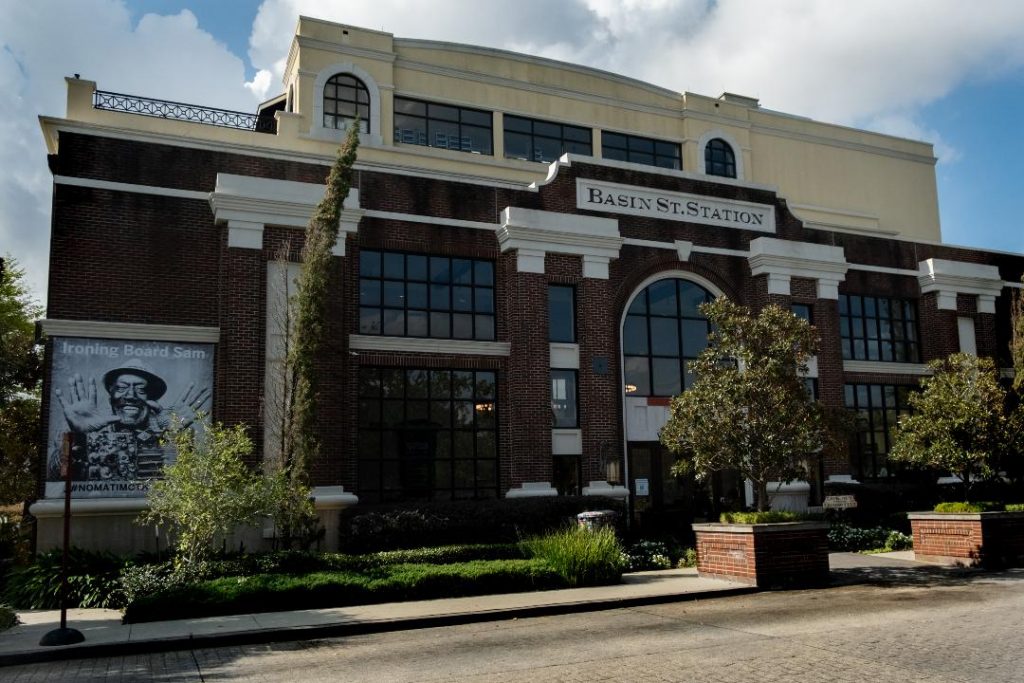
New Orleans honors Sam. (Courtesy of Tim Duffy.)
* * *
The NMAAM is another grand place for Ironing Board Sam’s legacy to land. The museum contains many remarkable levels of fortitude. It opened two years ago on Martin Luther King, Jr. Day—during a pandemic.
This is the only museum in the nation dedicated to preserving and celebrating the music genres created, influenced, and inspired by African-Americans. It is located just a block away from the Ryman, the original home of the Grand Ole Opry where Charley Pride became the first Black to sing at the Opry on Jan. 7 1967. DeFord Bailey was a Black harmonica player on the Opry between 1927 and 1941. Here is my 2003 Chicago Reader story on Mr. DeFord Bailey.
“I’m happy they have Sam’s keyboard,” Duffy said. “I was at the University of North Carolina Chapel Hill. Bill Ferris (long-time folklorist and former chairman of the National Endowment for the Humanities) was there and that’s where I met Dr. John Fleming.”
Fleming had been Museum Director in Residence of NMAAM. In 1998 he was director of the National Underground Railroad Freedom Center in Cincinnati and was consulting director of the International African American Museum Project in Charleston, S.C. Duffy recalled, “He told me about what they were doing in Nashville and that they were looking for artifacts.”
Besides the Ironing Sam keyboard, other keen museum items include a Johnny Otis Show bandstand, a trippy P-Funk era space robe worn by George Clinton, and a denim outfit that was designed by the late Lisa “Left Eye” Lopes of TLC. The outfit pledges “Stop Violence.”
There seemed to be an inordinate amount of panels and pictures, but that was offset by the museum’s commitment to interactive elements. Visitors can assemble music playlists, dance to the 1995 Montell Jordan hip-hop hit “This Is How We Do It,” write a blues song and sing the Edwin Hawkins hit “Oh Happy Day” in a gospel choir. The museum also features a 200-seat theater.
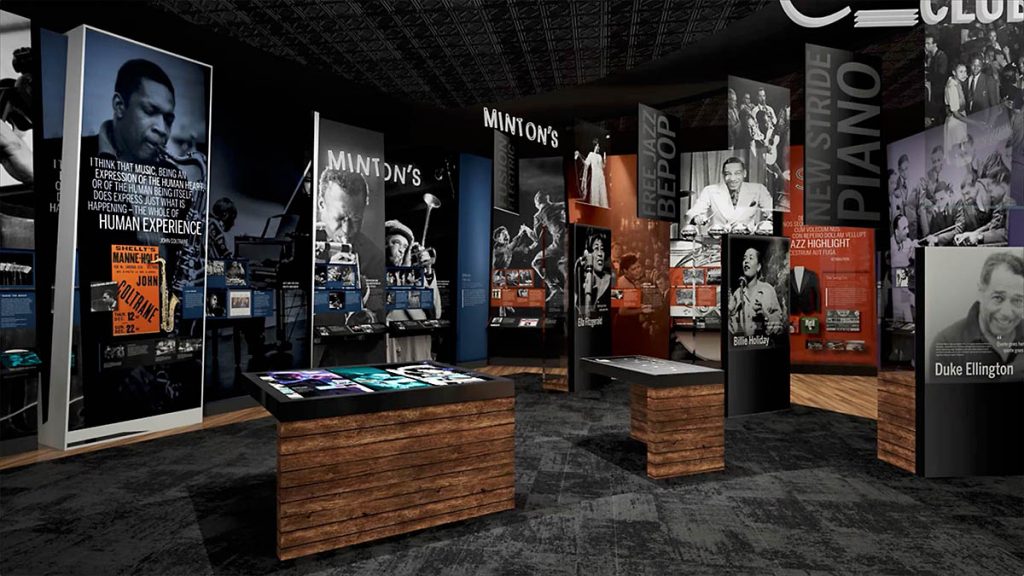
NMAAM is divided into five gallery sections that depict the rich 400-year timeline of African-American music and determination. The experience begins in the “Rivers of Rhythm” walkway that blends American history with music history as a nod to a Langston Hughes poem.
“Rivers of Rhythm” are appropriately close to “Wade in the Water” which features African-American spirituals and hymns with Mahalia Jackson, Thomas A. Dorsey, and more. The “Love Supreme” gallery is next, highlighting jazz with a gold-plated Louis Armstrong trumpet and a leopard skin fur coat worn by vocalist Ella Fitzgerald.
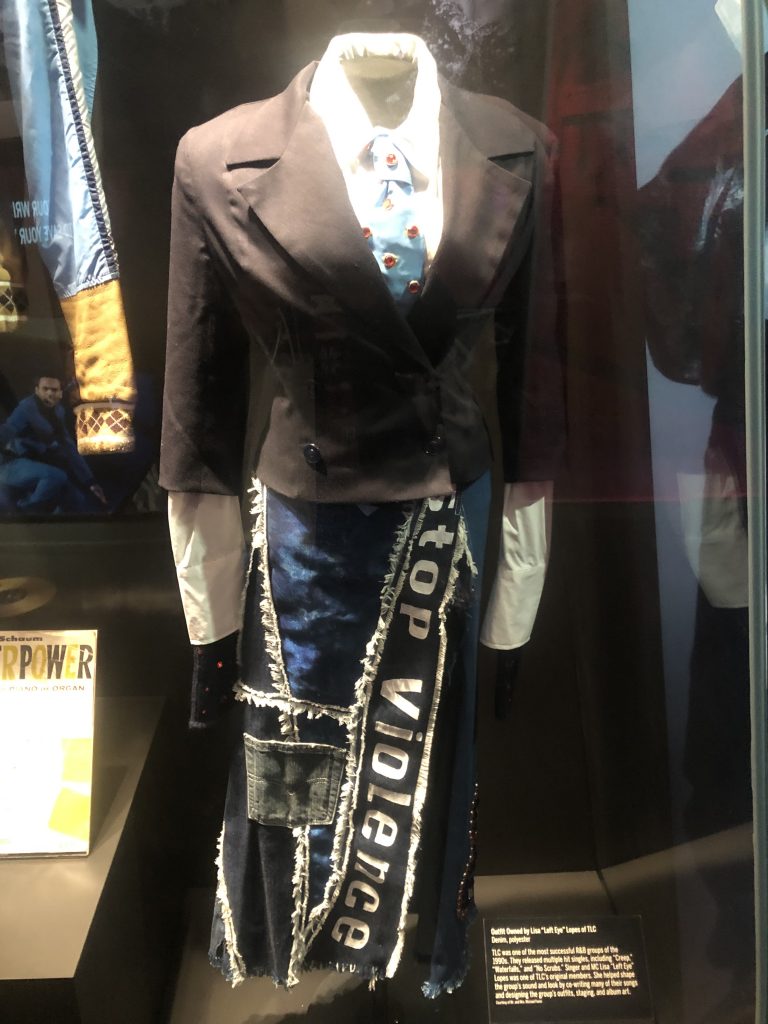
Lisa “Left Eye” Lopes outfit.
“One Nation Under a Groove” is next with exhibits centered around Motown, Stax, and the Soul Train enterprise, followed by “The Message” which honors hip-hop with a nice nod to Eric B. and Rakim. I’ve been to a lot of museums and this may be the first one that signifies Dope! And that’s dope!
On Jan. 19 NMAAM launches “This is Hip Hop,” a year-long photography exhibit that celebrates the 50th anniversary of the genre. Featured photographers are Chicago’s own (and former Chicago Defender lensman) Raymond Boyd for winter, Oakland, Ca.’s Traci Bartlow for spring, and two more TBA. In the future, the museum does need to place a greater priority on house music.
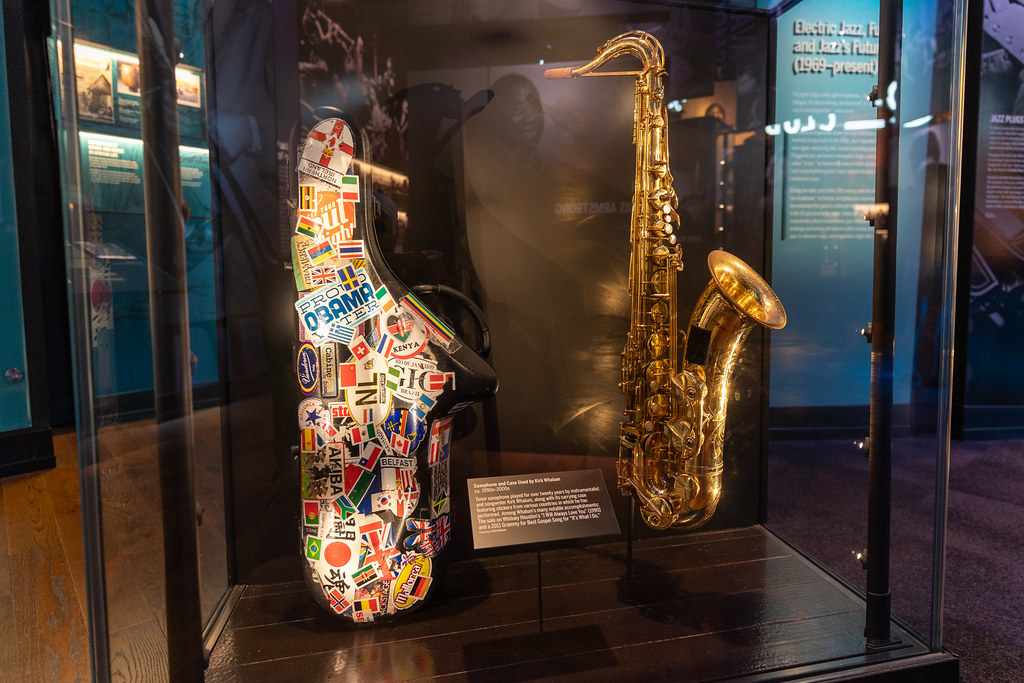
Kirk Whalum’s jazz saxophone and case at NMAAM (Provided photo.)
I told Duffy how seeing Moore’s keyboard struck a connective chord with me.
“That’s what it is with Sam,” he said. “Even living in this small town of Hillsborough. The pharmacist loved Sam. The hardware store. He rode around town on his bike. If anyone was broken down in a car, he would always stop no matter where it was. He’s a very kind guy.”
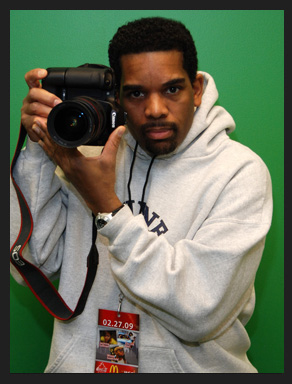
The work of Chicago hip hop photographer Raymond Boyd will be featured at NMAAM this winter.
The National Museum of African American Music is a bridge-building anchor of the new Fifth and Broadway mixed-use development in downtown Nashville. During two visits to the museum area, I ate at the Black-owned Slim & Husky’s pizza and the Black-owned Prince’s Hot Chicken, located in a food hall above the museum.
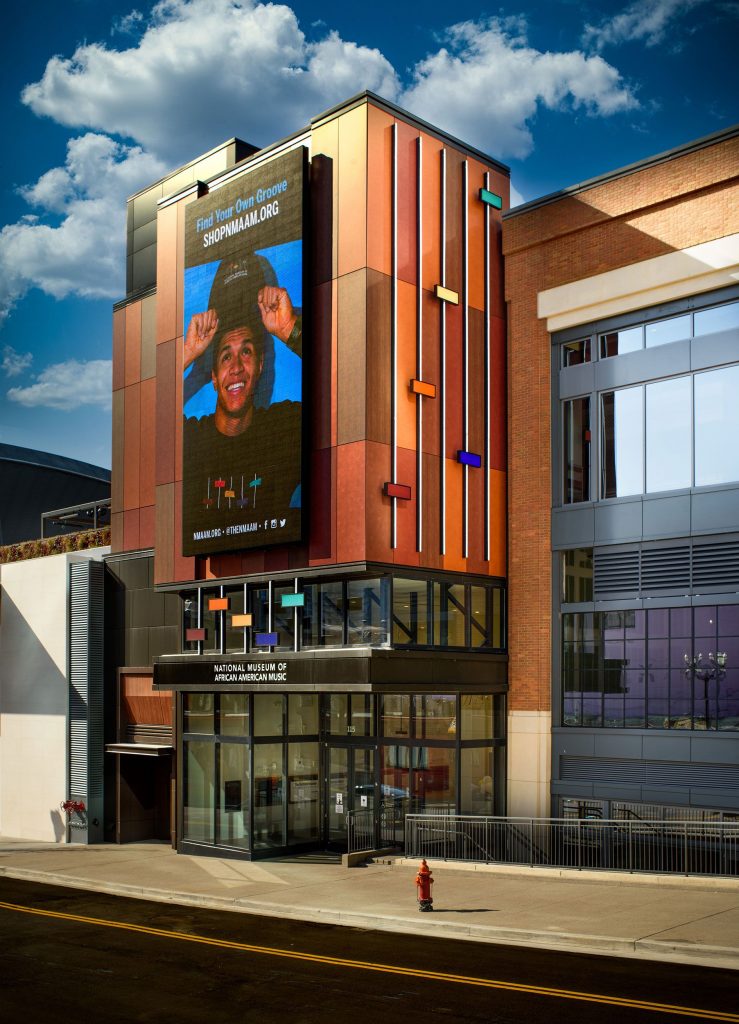
National Museum of African American Music
The downtown development is impressive and I get depressed when I return to Chicago and see how for years our city has dropped the ball for years on celebrating musical history.
The arts have been an important agenda item for Chicago’s Mayor Lightfoot, but the civic and business community needs to help jump the engine. Stop worrying about Soldier Field and invest in some kind of Chicago Music Center.
The $60 million NMAMM was funded in part by the City of Nashville and the state of Tennessee as well as private donors including Vanderbilt University, Amazon, Caterpillar, HCA Healthcare, the Mike Curb Foundation, Gibson guitars, and others.
We’re trying our best to move the needle forward in Chicago. Our acclaimed State of Sound exhibit at the Abraham Lincoln Presidential Library and Museum in Springfield, Il. covered the vast history of music in Illinois. In late April, a pop-up version of the exhibit will open at Navy Pier in Chicago.
The Greater Chicagoland Economic Partnership will be promoting the Chicago region over the next three years. Corporations will be pitched on our transportation connections and research institutions but a positive face can be placed on their companies by supporting Chicago’s vast musical landscape past present and future, just as they are doing quite well in Nashville, Tn.
The legacy of Ironing Board Sam shows the power of the dream.



Leave a Response